Chicken salad wraps recipe are a delicious and versatile meal option, perfect for lunch, dinner, or a quick snack. These wraps combine tender chicken, crunchy vegetables, and creamy dressing, all wrapped up in a soft tortilla. Whether you’re looking for a healthy option or something indulgent, chicken salad wraps offer a great balance of flavor and nutrition. In this article, we’ll explore how to make these tasty wraps, offer variations to suit different tastes, and provide tips for perfecting your recipe. Let’s get started!
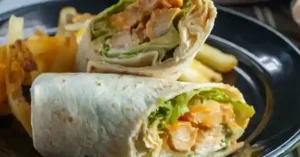
Introduction
Why Make Chicken Salad Wraps
Chicken salad wraps are a favorite for many reasons. They’re not only delicious but also incredibly versatile, making them a go-to option for a quick and satisfying meal. Here are a few reasons why you should consider making chicken salad wraps:
Versatility:
Whether you’re in the mood for a classic chicken salad or something more adventurous like a curry or spicy version, the possibilities are endless. You can customize the ingredients to suit your tastes and dietary preferences.
Convenience:
These wraps are easy to prepare and perfect for meal prep. You can make the chicken salad ahead of time and assemble the wraps when you’re ready to eat. They’re great for packed lunches, picnics, or on-the-go meals.
Nutritious:
Packed with protein, vegetables, and healthy fats, chicken salad wraps offer a balanced meal. You can control the ingredients to make them as light or hearty as you like, making them a suitable option for various diets.
Flavorful and Satisfying:
The combination of tender chicken, crunchy veggies, and a creamy dressing wrapped in a soft tortilla is both delicious and filling. Each bite is a blend of textures and flavors that can be tailored to your liking.
Benefits and Appeal of Chicken Salad Wraps
Chicken salad wraps appeal to a wide audience due to their adaptability and delicious taste. Here are some key benefits:
Customizable:
Easily modify the ingredients to cater to different dietary needs, such as gluten-free, low-carb, or dairy-free options.
Kid-Friendly:
Kids love the approachable flavors and fun wrap format, making it a family-friendly choice.
Ideal for Gatherings:
These wraps are excellent for parties or gatherings, as they can be prepared in advance and served as a finger food or main dish.
Health Conscious:
With options for adding fresh vegetables, lean proteins, and whole grain wraps, they can be a nutritious choice for health-conscious individuals.
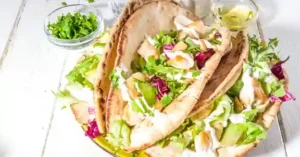
Ingredients
List of Necessary Ingredients
To make delicious chicken salad wraps, you’ll need the following ingredients:
- Chicken: The star ingredient, typically using cooked, shredded chicken breast or rotisserie chicken.
- Vegetables: Common choices include celery, lettuce, shallots, and sometimes diced apples or grapes for sweetness.
- Nuts and Dried Fruits: Walnuts or almonds add crunch, while dried cranberries or raisins provide a sweet contrast.
- Herbs: Fresh herbs like parsley, dill, or chives enhance the flavor.
- Dressing: A creamy dressing made from mayonnaise, Greek yogurt, or a combination. Season with salt, pepper, and optional ingredients like mustard or vinegar.
- Wraps: Soft tortillas, whole wheat wraps, or lettuce leaves for a low-carb option.
Ingredient Notes and Substitutions
- Chicken: Feel free to use leftover roasted chicken or even canned chicken for convenience. For a healthier option, use skinless chicken breast.
- Vegetables: You can swap out or add in different vegetables based on preference or what you have on hand. Bell peppers, cucumbers, or shredded carrots are good alternatives.
- Nuts and Dried Fruits: If you’re allergic to nuts or prefer a different flavor, consider using seeds like sunflower or pumpkin seeds. Dried apricots or chopped dates can replace cranberries.
- Herbs: Fresh herbs are ideal, but dried herbs can be used if fresh ones aren’t available. Adjust the quantity as dried herbs are more potent.
- Dressing: For a lighter option, use Greek yogurt instead of mayonnaise. Add a splash of lemon juice or vinegar for tanginess. You can also use a vinaigrette dressing for a different flavor profile.
- Wraps: Whole wheat tortillas add fiber and nutrients, while spinach or tomato wraps offer additional flavor. For a low-carb or gluten-free option, use large lettuce leaves or gluten-free wraps.
Variations
- Curry Chicken Salad: Add curry powder to the dressing and include raisins or diced apples for a sweet, savory twist.
- Spicy Chicken Salad: Mix in hot sauce or diced jalapeños for heat. You can also add a pinch of cayenne pepper to the dressing.
- Cheesy Chicken Salad: Incorporate shredded cheese like cheddar or mozzarella into the salad mixture.
- Chicken Salad Wrap with Grapes: Add halved grapes for a juicy burst of sweetness.
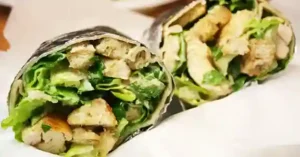
Equipment Needed
Preparing chicken salad wraps is simple and doesn’t require much specialized equipment. However, having the right tools on hand can streamline the process and ensure consistent results. Here’s a list of essential equipment you’ll need:
Essential Tools for Preparation
Cutting Board and Knife
- Purpose: To chop and prepare the chicken, vegetables, and herbs.
- Tip: Use a sharp knife to make clean cuts, which helps maintain the texture and appearance of the ingredients.
Mixing Bowls
- Purpose: To combine the chicken salad ingredients and mix the dressing.
- Tip: Use a large bowl for the salad to ensure you have enough space to mix thoroughly without spilling.
Measuring Cups and Spoons
- Purpose: To accurately measure ingredients, especially for the dressing and any seasonings.
- Tip: Accurate measurements ensure a balanced flavor in the salad and dressing.
Tongs or Salad Spoons
- Purpose: To toss the salad ingredients and mix them evenly with the dressing.
- Tip: Use tongs for better control and less mess, especially when dealing with leafy greens or large pieces of chicken.
Grater or Zester
- Purpose: To grate cheese, zest citrus fruits, or finely chop ingredients like garlic or ginger.
- Tip: A microplane grater is versatile and great for achieving fine textures.
Serving Platter or Plates
- Purpose: To assemble and serve the wraps.
- Tip: Use a large, flat surface to lay out the tortillas or wraps for easy filling and rolling.
Plastic Wrap or Reusable Food Covers
- Purpose: To store any leftover salad or assembled wraps.
- Tip: Cover tightly to maintain freshness, especially if preparing in advance.
Food Processor or Blender (Optional)
- Purpose: For making smooth, creamy dressings or finely chopping ingredients like nuts.
- Tip: This tool is helpful for those who prefer a more consistent texture in their salad or dressing.
Optional Equipment
Salad Spinner
- Purpose: To dry leafy greens quickly and efficiently.
- Tip: Removing excess water from greens helps prevent soggy wraps.
Cast Iron Skillet or Grill Pan
- Purpose: To warm the tortillas or grill chicken for added flavor.
- Tip: Lightly warming the tortillas makes them more pliable and easier to roll.
Mandoline Slicer
- Purpose: For uniformly slicing vegetables like cucumbers, carrots, or onions.
- Tip: Be cautious when using, as the blades are very sharp.
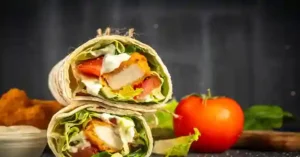
Step-by-Step Instructions
Creating the perfect chicken salad wraps involves a few key steps, from preparing the ingredients to assembling and rolling the wraps. Here’s a detailed guide to help you make delicious chicken salad wraps at home:
How to Make Chicken Salad
Cook the Chicken:
- Options: You can use leftover chicken, rotisserie chicken, or cook fresh chicken breasts.
- Cooking Fresh Chicken: If using fresh chicken, season the breasts with salt and pepper. Cook them in a skillet with a little olive oil over medium heat until fully cooked, about 5-7 minutes per side. Alternatively, you can bake them in the oven at 375°F (190°C) for 20-25 minutes.
- Shredding: Once cooked, let the chicken cool slightly before shredding it with two forks or chopping it into small cubes.
Prepare the Vegetables and Add-Ins:
- Chopping: Dice celery, shallots, and any other vegetables you’re using. For a sweeter touch, add diced apples or halved grapes.
- Nuts and Fruits: Chop nuts like walnuts or almonds, and add dried cranberries or raisins if desired.
Make the Dressing:
- Base Ingredients: Combine mayonnaise, Greek yogurt, or a mix of both. Adjust the ratio based on your preference for creaminess.
- Seasoning: Add salt, pepper, and a splash of white wine vinegar or lemon juice for acidity. Mix in herbs like parsley, dill, or chives for added flavor.
- Mix: Whisk until smooth and well combined.
Combine Ingredients:
- Mixing: In a large mixing bowl, combine the shredded chicken, chopped vegetables, nuts, and dried fruits. Pour the dressing over the mixture.
- Tossing: Use tongs or salad spoons to toss everything together until the chicken and vegetables are evenly coated with the dressing.
Assembling the Wrap
Preparing the Wraps:
- Warming: Warm the tortillas or wraps slightly to make them more pliable. You can do this in a dry skillet over medium heat for a few seconds on each side, or microwave them for 15-20 seconds.
Filling the Wraps:
- Layering: Place a lettuce leaf (if using) on the tortilla to help prevent sogginess. Spoon the chicken salad mixture onto the center of the wrap.
- Amount: Be mindful not to overfill, as this can make the wrap difficult to roll and more prone to breaking.
Rolling the Wraps:
- Folding: Fold in the sides of the tortilla over the filling, then roll tightly from the bottom up to secure the contents.
- Securing: Use toothpicks if needed to hold the wrap together, especially if preparing them in advance.
How to Roll Chicken Wraps
- Place the Filling: Arrange the chicken salad horizontally across the middle of the wrap, leaving space on the sides.
- Fold the Sides: Fold the sides of the wrap towards the center over the filling.
- Roll Tightly: Starting from the bottom, roll the wrap tightly while keeping the sides tucked in. This helps prevent the filling from spilling out.
- Cut and Serve: If desired, slice the wrap in half diagonally for easier eating and a more appealing presentation.
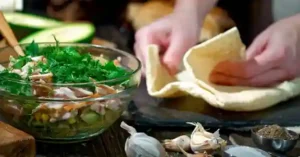
Recipe Variations
Chicken salad wraps are wonderfully versatile, allowing you to experiment with different ingredients and flavors to suit your tastes and dietary needs. Here are some creative variations to try, each bringing its unique twist to the classic recipe:
Curry Chicken Salad Wraps
Flavor Profile:
Adds a warm, aromatic spice to the traditional chicken salad.
Ingredients:
- Chicken Salad: Use the standard base of chicken, celery, and mayonnaise.
- Additional Ingredients: Add curry powder (start with 1-2 teaspoons and adjust to taste), raisins or diced apples for sweetness, and a pinch of cayenne pepper for heat.
- Garnish: Include chopped cilantro and a squeeze of lime juice for a fresh finish.
- Wrap: Serve in a regular or whole wheat tortilla, or for a lighter option, use large lettuce leaves.
Spicy Chicken Salad Wraps
Flavor Profile:
Offers a kick of heat, perfect for spice lovers.
Ingredients:
- Chicken Salad: Combine with standard ingredients plus hot sauce (such as Sriracha), diced jalapeños, or crushed red pepper flakes.
- Additional Ingredients: Include chopped bell peppers for a crunchy texture and balance the heat.
- Garnish: Add a sprinkle of cheddar cheese and some avocado slices for creaminess.
- Wrap: Use spinach tortillas for added flavor and color.
Cheesy Chicken Salad Wraps
Flavor Profile:
Creamy and rich, with the added goodness of cheese.
Ingredients:
- Chicken Salad: Add shredded cheese like cheddar, Monterey Jack, or mozzarella to the mixture.
- Additional Ingredients: You can also include finely chopped green onions or chives.
- Garnish: Top with a little extra cheese before wrapping for a gooey finish.
- Wrap: A plain or flavored tortilla works well, warmed slightly to melt the cheese.
Chicken Salad Wrap with Grapes
Flavor Profile:
Combines savory chicken salad with the sweet, juicy burst of grapes.
Ingredients:
- Chicken Salad: Add halved red or green grapes to the standard chicken salad mixture.
- Additional Ingredients: Include chopped walnuts for crunch and extra texture.
- Garnish: Fresh herbs like tarragon or basil can complement the sweetness of the grapes.
- Wrap: Use a whole wheat or multigrain tortilla for a heartier base.
Low-Carb Chicken Salad Wraps (Lettuce Wraps)
Flavor Profile:
Fresh and light, focusing on the chicken salad without the carbs from the tortilla.
Ingredients:
- Chicken Salad: Keep the ingredients simple, focusing on high-protein, low-carb components.
- Wrap: Use large lettuce leaves (such as iceberg, romaine, or butter lettuce) as the wrap. These are crisp and hold up well to the filling.
- Garnish: Add avocado slices, cucumber strips, or bell pepper slices for extra crunch and nutrition.
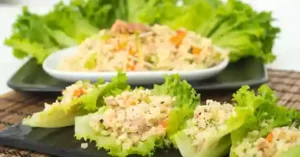
Tips for the Best Chicken Salad Wraps Recipe
Creating the perfect chicken salad wraps involves more than just following a recipe. Here are some expert tips and tricks to help you achieve the best flavor, texture, and presentation, ensuring your wraps are always a hit.
Expert Tips
Use Fresh Ingredients:
Fresh vegetables, herbs, and quality chicken make a noticeable difference in flavor and texture. Whenever possible, opt for fresh over canned or frozen ingredients.
Properly Cook the Chicken:
If cooking the chicken yourself, avoid overcooking, as this can make it dry. For the juiciest results, cook until just done and let it rest before shredding or dicing.
Balance the Dressing:
The dressing is crucial for flavor and texture. Taste and adjust the seasoning before mixing it with the chicken and other ingredients. Add a little at a time to avoid overdressing, which can make the salad too creamy or soggy.
Add Ingredients Gradually:
When mixing the salad, add the dressing and other ingredients gradually. This allows you to control the consistency and ensures an even distribution of flavors.
Chill the Salad:
Allow the chicken salad to chill in the refrigerator for at least 30 minutes before assembling the wraps. This helps the flavors meld together and makes the salad easier to work with.
Warm the Wraps:
Slightly warming the tortillas or wraps makes them more pliable, reducing the risk of tearing and making them easier to roll tightly.
Layering Ingredients:
Start with a base layer of lettuce or another green to add a barrier between the wrap and the salad, preventing sogginess. Place heavier ingredients like chicken and nuts first, then layer lighter items like vegetables on top.
Don’t Overfill:
Overfilling the wraps can make them difficult to roll and eat. Use a moderate amount of filling and ensure the ends can be folded in before rolling tightly.
Secure the Wraps:
Use toothpicks or wrap the rolls in parchment paper or foil if serving later. This helps maintain their shape and makes them easier to handle.
Presentation:
For a clean presentation, slice the wraps diagonally. This not only looks appealing but also makes them easier to eat, especially for kids or at gatherings.
Common Mistakes to Avoid
Overcooking the Chicken:
Overcooked chicken can become dry and tough, which affects the overall texture of the salad. Always check for doneness but aim for juiciness.
Using Watery Ingredients:
Ingredients like tomatoes or cucumbers can release water, making the salad runny. If using these, deseed them or pat them dry before adding to the mix.
Under-seasoning:
Be generous with seasoning but also taste as you go. Chicken salad can easily be bland if not properly seasoned, so adjust salt, pepper, and other spices according to taste.
Too Much Dressing:
While dressing adds flavor, too much can overwhelm the salad and make it soggy. Start with less and add more if needed.
Skipping the Chilling Step:
Chilling the salad is crucial for the flavors to develop and meld together. It also firms up the salad, making it easier to work with.

Serving Suggestions
Chicken salad wraps are versatile and can be paired with various sides and beverages to create a complete meal. Whether you’re serving them for a casual lunch, a picnic, or a party, here are some great ideas for what to serve alongside chicken salad wraps to enhance the dining experience.
What to Serve with Chicken Salad Wraps
Salads:
Green Salad:
A simple green salad with a light vinaigrette pairs well with chicken salad wraps. Consider adding ingredients like cucumbers, cherry tomatoes, or avocado for extra flavor.
Fruit Salad:
A fresh fruit salad, featuring fruits like berries, melons, and grapes, adds a sweet contrast to the savory wraps.
Pasta Salad:
A chilled pasta salad with a light dressing and fresh vegetables can complement the wraps, offering a different texture and taste.
Soups:
Gazpacho:
This cold, refreshing soup is perfect for summer and pairs well with the flavors in chicken salad wraps.
Tomato Soup:
A classic tomato soup, served hot or cold, provides a comforting and familiar pairing.
Chicken or Vegetable Soup:
A light broth-based soup with vegetables or noodles can make the meal more filling without being heavy.
Chips and Dips:
- Vegetable Chips: Serve with hummus or a Greek yogurt dip for a crunchy, healthy side.
- Tortilla Chips: Pair with salsa, guacamole, or a creamy dip like ranch or blue cheese.
- Pita Chips: These go well with Mediterranean dips like tzatziki or baba ghanoush, adding a bit of variety to the meal.
Breads and Rolls:
Crusty Bread:
A slice of crusty baguette or sourdough can be a great accompaniment, especially if you want to dip it in soup or use it to scoop up any extra chicken salad.
Dinner Rolls:
Soft dinner rolls provide a mild, comforting side that complements the flavors in the wraps.
Flatbread:
Flatbreads can be served alongside for dipping in any extra dressing or used as an additional base for the chicken salad.
Pickles and Relishes:
- Pickles: Dill pickles, bread and butter pickles, or pickled vegetables add a tangy, crunchy contrast to the creamy chicken salad.
- Relishes: Sweet or spicy relishes can enhance the flavor profile and add an interesting twist.
Beverages:
- Iced Tea: A classic pairing, whether sweetened or unsweetened, complements the savory flavors of the wraps.
- Lemonade: Freshly squeezed lemonade or a lemonade-iced tea blend provides a refreshing, citrusy note.
- Wine or Beer: A light white wine, such as Sauvignon Blanc or Pinot Grigio, pairs well, as does a light, crisp beer like a lager or pilsner.
Desserts:
- Fruit Sorbet: A light, refreshing dessert that cleanses the palate.
- Cookies: Simple cookies like shortbread or sugar cookies provide a sweet end to the meal without being too heavy.
- Yogurt Parfait: Layered with fresh fruits and granola, yogurt parfaits offer a balanced, healthy dessert option.

Storage and Make-Ahead Tips
Proper storage and make-ahead strategies are key to maintaining the freshness and quality of your chicken salad wraps. Whether you’re preparing them for meal prep, a party, or simply want to save leftovers, here are some tips to ensure they stay delicious.
Storage Tips
Chicken Salad:
Refrigeration:
Store the chicken salad mixture in an airtight container in the refrigerator. It can last for up to 3-4 days, but for the best flavor and texture, consume within the first 2 days.
Separation:
Keep the chicken salad separate from the wraps until ready to assemble. This prevents the wraps from becoming soggy.
Wraps and Tortillas:
Room Temperature:
Store tortillas or wraps at room temperature in their original packaging or an airtight container. Once opened, they should be used within a week.
Refrigeration/Freezing:
If you have extra wraps or tortillas, they can be stored in the refrigerator for up to two weeks or frozen for up to three months. Separate each wrap with wax paper and store in a freezer bag to prevent sticking.
Assembled Wraps:
Short-Term Storage:
If you need to store assembled wraps, wrap them individually in plastic wrap, foil, or parchment paper to keep them fresh. Store them in the refrigerator for up to 1 day. For added freshness, you can also place them in an airtight container.
Avoid Sogginess:
To prevent sogginess, avoid overfilling with wet ingredients, and place a layer of lettuce between the salad and the wrap. This acts as a barrier and helps maintain the wrap’s integrity.
Make-Ahead Tips
Prepping Ingredients:
Chicken:
Cook and shred or chop the chicken ahead of time. Store it in an airtight container in the refrigerator for up to 3 days. You can also freeze cooked chicken for longer storage.
Vegetables and Herbs:
Chop vegetables and herbs in advance and store them separately in the refrigerator. Use within 1-2 days for the best freshness.
Dressing:
Make in Advance:
Prepare the dressing ahead of time and store it in a sealed container in the refrigerator. It can typically last for up to a week, depending on the ingredients used.
Add Just Before Serving:
Mix the dressing with the chicken salad just before assembling the wraps to maintain the freshness and prevent the salad from becoming overly moist.
Assembling Ahead:
Day of Serving:
For the best results, assemble the wraps the day you plan to serve them. If necessary, they can be made a few hours ahead and stored in the refrigerator.
Pack Separately for Lunches:
If using the wraps for meal prep or packed lunches, store the salad and wraps separately, and assemble just before eating. This keeps the wraps from getting soggy.
Freezing:
Chicken Salad:
Freezing the chicken salad itself is not recommended as mayonnaise-based dressings can separate and the texture of fresh vegetables may change. However, you can freeze cooked chicken and use it later to make the salad fresh.
Wraps/Tortillas:
Wraps can be frozen, as mentioned above. Just ensure they are thawed properly before use.

Nutrition Information
Understanding the nutritional profile of chicken salad wraps can help you make informed choices, whether you’re tracking specific dietary goals or simply interested in what you’re eating. Here’s a breakdown of the typical nutrition components, including ways to adjust for dietary needs.
General Nutritional Overview
A standard chicken salad wrap typically includes chicken, mayonnaise or a similar dressing, vegetables, and a tortilla. Here’s a basic breakdown:
Calories:
The calorie content can vary significantly based on portion sizes and ingredients. On average, a chicken salad wrap might contain between 300 to 500 calories.
Protein:
- Chicken: The primary source of protein, with a wrap containing roughly 20-30 grams, depending on the amount of chicken used.
- Other Ingredients: Additional protein may come from ingredients like Greek yogurt (if used in the dressing) or cheese.
Carbohydrates:
- Tortilla: The main source of carbohydrates, contributing around 20-30 grams per wrap.
- Vegetables: Additional carbs, though usually low, come from vegetables like celery, grapes, or apples.
- Sugars: Natural sugars are present in fruits and may also come from any added sugar in the dressing.
Fats:
- Dressing: Mayonnaise or similar dressings add fats, which can vary based on the type used. For instance, using full-fat mayonnaise versus a lighter version or Greek yogurt will change the fat content.
- Healthy Fats: Ingredients like avocados, olive oil, or nuts (like walnuts) add healthy fats.
Fiber:
- Vegetables and Wraps: The fiber content comes from the vegetables and the tortilla. Using whole-grain wraps can increase fiber intake.
Vitamins and Minerals:
- Vitamins: Vegetables and herbs contribute to vitamins like vitamin C, vitamin K, and various B vitamins.
- Minerals: Key minerals include calcium (especially if cheese is added), potassium, and iron.
Adjusting for Dietary Needs
Lowering Calories:
Use a lighter dressing base, such as Greek yogurt instead of mayonnaise. Choose a smaller or low-calorie tortilla, or use lettuce leaves as a wrap alternative.
Increasing Protein:
Add extra chicken or incorporate additional protein-rich ingredients like Greek yogurt, cottage cheese, or legumes.
Reducing Carbohydrates:
Opt for low-carb tortillas or lettuce wraps. Limit or omit high-carb add-ins like dried fruits or sugary dressings.
Healthy Fats:
Focus on healthy fat sources like avocados, nuts, and olive oil-based dressings. Reduce or replace mayonnaise with Greek yogurt or a light vinaigrette to lower saturated fats.
Boosting Fiber:
Use whole-grain or high-fiber tortillas. Add more fiber-rich vegetables like leafy greens, bell peppers, and cucumbers.
Allergen Considerations:
For those with dairy allergies, use dairy-free alternatives for dressings and cheeses. If gluten is a concern, select gluten-free wraps or use lettuce leaves as a substitute.
Example Nutritional Breakdown (per wrap)
- Calories: Approximately 350-450 kcal
- Protein: 20-25 grams
- Carbohydrates: 25-35 grams
- Fats: 15-20 grams
- Fiber: 3-6 grams
- Sugar: 3-8 grams (varies with fruit and dressing)
- Sodium: 600-800 mg (varies with dressing and added salt)
Conclusion
In conclusion, chicken salad wraps are a versatile and delicious option that can be easily customized to suit various tastes and dietary preferences. Whether you’re looking for a quick meal, a healthy lunch option, or a crowd-pleasing dish for gatherings, these wraps offer endless possibilities. By experimenting with different ingredients, such as various proteins, vegetables, and dressings, you can create unique flavor profiles that keep this classic dish exciting and enjoyable. The ease of preparation, combined with the ability to make them ahead of time, makes chicken salad wraps a convenient and satisfying choice for any occasion. Enjoy the creativity and simplicity of crafting your perfect wrap, and relish in the delightful combination of flavors and textures with each bite.

